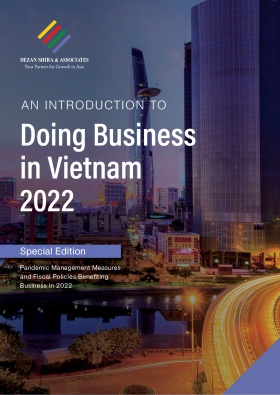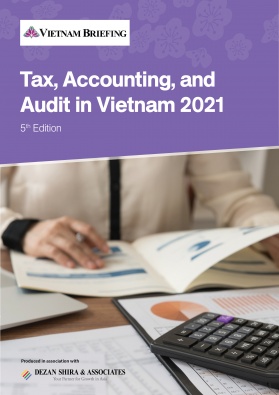Vietnam’s Year in Review and Outlook for 2022
- Vietnam suffered a challenging 2021, as it was hit hard by the pandemic, resulting in stringent lockdowns and affecting economic growth.
- Sustained pressure from COVID-19 outbreaks and supply chain disruption are likely to continue to have an impact into 2022.
- Nevertheless, with Vietnam slowly reopening, foreign investors maintain an optimistic outlook, with GDP projected at 6.5 percent in 2022.
- Vietnam Briefing examines some significant events that occurred this year and how they are likely to shape Vietnam’s business environment in 2022.
Vietnam’s 2021 was by far one of the most challenging years to date. While Vietnam was lauded globally for controlling the pandemic in 2020, the Delta variant proved overwhelming resulting in strict lockdowns, interrupted production, and disrupted supply chains.
While most western countries suffered an excruciating 2020, Vietnam’s 2021 was harsh with the pandemic hitting Vietnam’s GDP hard. In Q3 2021, Vietnam recorded its first-ever negative GDP, since 2000 affecting businesses and its people significantly.
Nevertheless, Vietnam still expects a positive GDP and as the government switches to a ‘living with the pandemic’ strategy, further economic gains can be expected. While most banks and international institutions have revised their forecast for Vietnam’s GDP downward, they still maintain strong business sentiment followed by positive GDP growth in the foreseeable future.
For 2022, Vietnam’s government has forecast GDP growth of 6 to 6.5 percent.
As we wrap up 2021, we look at significant events that occurred in 2020, that are further likely to shape Vietnam’s business environment in 2022.
COVID-19 and supply chains
The fourth wave of the pandemic had a significant effect on businesses and people like. Most of the country was ordered into a strict lockdown where people were only allowed to go out for emergencies. Businesses and factories that wanted to operate had to implement a 3-on-site work model where employees eat, sleep and work on-site, or one road-two destinations model, where employees stay in dormitories or hotels and are transported in company vehicles to the worksite and back.
Businesses had significant difficulties arranging this on short notice, which also added to increased costs as they had to find accommodation and provide food on site. This resulted in several factories shutting down. Even with this model, several employees were infected with COVID-19 resulting in the closure of factories.
Due to such factory closures, several international businesses, such as Nike, Abercrombie & Fitch, Adidas, and Everlane were significantly affected. Apparel company Everland said it faced four to eight weeks of delays, while Nike cited 10 weeks of lost production.
This came at a time when western markets such as the US and Europe faced increased demand for products during the busy holiday season. The strict movement restrictions amplified the situation with increased testing of truck drivers, goods stuck at ports, factories, and warehouses. Further businesses have stated that even with the reopening, it may take another five to six months to ease such supply chain issues.
Nevertheless, things seem to be looking up. Nike is confident that the resumption of factories will boost the company’s recovery. In addition, Vietnam has been ramping up its vaccination. From being less than 3 percent fully vaccinated in July 2021 to now more than 69 percent of its population fully vaccinated, it is on par, if not exceeding with countries like the US. While the Omicron variant will prove challenging, Vietnam’s economy seems resilient and is likely to weather the storm.
However, the situation is not unique to Vietnam, businesses will need to evolve, diversify and look to reduce costs to ensure that their supply chains are resilient. And while supply chain is an issue, ports in the US and other localities are also overburdened with containers unable to get to their destinations.
Businesses need to look at other locations depending on the type of industry and raw materials to ensure contingency plans remain in place. With a vaccine supply improving and global air travel steadily resuming, businesses should take the opportunity to ensure a reliable supply chain with fool-proof plans in place for the future.
Free trade agreements and the RCEP
Vietnam’s free trade agreements (FTAs) are another pull factor that investors can bank on. Vietnam has used its participation in FTAs as an instrument to ensure increased economic power and financial security. This will ensure that Vietnam’s economic development will continue to shift away from exporting low-tech manufacturing products and primary goods to more complex hi-tech goods like electronics, machinery, vehicles, and medical devices. The implementation of the EU-Vietnam free trade agreement (EVFTA) last year is an example of this.
The upcoming Regional Comprehensive Economic Partnership (RCEP) will officially come into force on January 1, 2022. The RCEP will reduce tariffs and set trade rules and help link supply chains, particularly as governments grapple with COVID-19 effects. The FTA is expected to cover all aspects of business including trade, services, e-commerce, telecommunications, and copyright.
Tariffs are expected to be reduced within 20 years. The RCEP covers a market of 2.3 billion people and US$26.2 trillion in global output. This accounts for about 30 percent of the population worldwide and over a quarter of world exports. Documents from the World Bank forecast that countries part of the RCEP will see GDP increase by 1.5 percent. Economists note that the deal could add almost US$200 billion to the global economy by 2030.
As Vietnam moves to become a high-tech manufacturer, the RCEP can help local firms increase exports and attract high-quality goods for its consumers. In addition, with the demand for Vietnam’s exports like agriculture and fisheries products, Vietnam is set to benefit.
Mergers and acquisitions
Mergers and acquisitions (M&A) are likely to continue to play a key role in Vietnam’s economy in 2022. While in 2020 M&A activities were disrupted due to the pandemic, in the first nine months of 2021, M&A deals with total disclosed value have already totaled US$3 billion. Domestic firms have led the M&A market recently with Masan Group and Vingroup acquiring businesses in hi-tech and retail industries. The top three sectors by most deals for M&A activity were industrials and chemicals, consumer goods, and real estate in 2021.
Nevertheless, investors are cautious to cater to pandemic-related risks. The government has also eased some requirements in the investment and enterprise laws to facilitate M&A deals. As Vietnam hopes to recover its economy, further robust M&A activity can be expected in 2022.
Government support packages
Due to the pandemic, the government unveiled several support packages for businesses and individuals to help spur the economy. Businesses should prepare for 2022, using these government measures to improve cash flow.
For example, Vietnam issued Resolution 406 which included a 30 percent corporate income tax (CIT) cut. The CIT reduction applied to all businesses that had revenue of less than VND 200 billion (US$8.8 million) in 2021. This means all businesses including SMEs are eligible regardless of the number of employees and the actual financial loss due to the pandemic. Further support measures were issued in the form of land rent reductions, social insurance, unemployment insurance benefits, and one-time payments.
Foreign employee work permits
After tightening requirements on foreign employees as per Decree 152 which was issued earlier in the year, the government issued Resolution 105 easing requirements of issuing and renewing work permits. Mainly, as per the resolution, the education degree does not have to be related to the job position in Vietnam, and that the work experience in Vietnam can be counted rather than the work experience from the home country.
In addition, the notarization of passports has been removed, rather just a copy of the passport is sufficient. The recent updates show that the government is listening to business entities after they voice concerns over Decree 152 requirements. The easing of requirements should help businesses and employees enter Vietnam for job opportunities along with the easing of entry procedures from next year.
Tourism
Vietnam’s tourism industry and jobs related to the industry have suffered significantly due to COVID-19. Before the pandemic, in 2019, Vietnam welcomed 18 million tourists, an all-time high. Compared this to 2020, where, in the first 11 months of the year, only 140,100 tourists arrived, down 96.3 percent year on year.
Even this figure is due to the government allowing a pilot program allowing international tourists at designated tourist destinations. Nevertheless, the government is also developing a roadmap to fully open up to international visitors by June 2022. The plan has already begun to be implemented with fully vaccinated international tourists arriving to Phu Quoc, Hoi An, and Nha Trang on packaged tours.
From 2022 the government plans to allow international arrivals that are fully vaccinated to self-quarantine at home or their places of accommodation as long as they test negative. This could all change, however, due to the new Omicron variant, but the government remains keen to reopen tourism. The Ministry of Culture, Sports, and Tourism has proposed that the Prime Minister consider restoring visa exemption for tourists who stay in Vietnam for less than 15 days. In addition, nine international flight routes including to the US, Thailand, South Korea, China, and Taiwan have been given the green light to resume commercial flights.
Heading into 2022
2021 brought significant challenges for many businesses in Vietnam who had to deal with local market developments along with concerns plaguing global supply chains exacerbated by the pandemic. Several issues that Vietnam faced in 2021 are likely to continue into 2022. Nevertheless, a more targeted and focused development in key areas of the economy will present more opportunities for growth, particularly, in areas that help prop up Vietnam’s bottom line of economic stability and people’s livelihoods.
Vietnam’s economic restructure plan for the 2021-2025 period, approved by the National Assembly, focuses on the digital economy, hi-tech industries, developing the urban economy, strengthening regional connectivity, strengthening the role of key economic zones, and restructuring to achieve a green and sustainable economy among others.
Given the dynamic business climate, understanding Vietnam’s policies and development goals will be necessary to make timely adjustments to business development strategies and avoid compliance risks.
While Vietnam has suffered, its economy is on course to record positive growth in 2022. For the next year, Vietnam remains a strong candidate for investment from ASEAN and beyond. Given its investor-friendly policies, relative economic and political stability, cost efficiency, and consumer demand prospects, Vietnam is likely to continue gaining from supply chains restructuring in Asia in addition to attracting a new range of investors in terms of geography and sectors.
About Us
Vietnam Briefing is produced by Dezan Shira & Associates. The firm assists foreign investors throughout Asia from offices across the world, including in Hanoi, Ho Chi Minh City, and Da Nang. Readers may write to vietnam@dezshira.com for more support on doing business in Vietnam.
We also maintain offices or have alliance partners assisting foreign investors in Indonesia, India, Singapore, The Philippines, Malaysia, Thailand, Italy, Germany, and the United States, in addition to practices in Bangladesh and Russia.
- Previous Article An Introduction to Doing Business in Vietnam 2022 – New Publication from Dezan Shira & Associates
- Next Article Why Manufacturing is Driving Vietnam’s Growth







